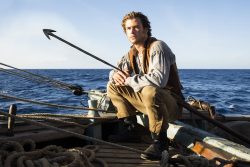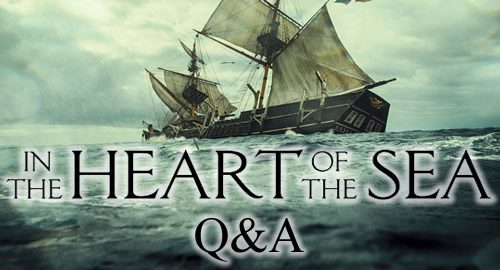We have just been sent over a great Q&A for In the Heart of the Sea. this is where we talk to not only the stars of the film but the people behind the camera helping bringing the story to life
We talk to stars, Chris Hemsworth, Benjamin Walker and Tom Holland. We also talk to the director, Ron Howard ,and the screenwriter of the film, Charles Leavitt, and the author, Nathaniel Philbrick, of the book that the film is based on.
Not only that, we have been sent over some great images that show more of what’s it going to be like in the film.
 QUESTION: Ron, what drew you to want to make In the Heart of the Sea?
QUESTION: Ron, what drew you to want to make In the Heart of the Sea?
RON HOWARD: It was a combination of things. I’ve long had an interest in doing a movie set in the ocean. There were sequences from Splash and Cocoon on and underwater, and I was comfortable enough. I don’t love the ocean. It’s not a place I go for recreation, but I think there’s something about the power and the mystery of it that has always drawn me to the dramatic potential of it. Many years ago, I tried to get a movie made about a Greenpeace ship, the Rainbow Warrior, which had been confiscated at one point. I wanted to tell that story but could never get the resources together to tell that one. Later, I came very close to making The Sea-Wolf, a Jack London drama set on the ocean. Powerful. Didn’t quite come together.
When this one came to me, it embodied, I thought, the cinematic potential that those movies offered as a drama. It also offered this chance to sort of demystify Moby-Dick, because I had no idea the mythology was inspired by real events, and the screenplay was really strong. When I found out it was a true story and went back and sort of reconciled the two, I was impressed by the adaptation. And – last but probably most important – was that Chris Hemsworth brought it to me. We had had such a good experience on Rush, and I just had so much respect for Chris, and thought he was really born to play Owen Chase. I knew I liked working with him; I knew what he could do with it; and I knew it was going to be a tremendous challenge. But with Chris in that all-important leadership role, not only would we be in good shape in front of the camera, but also I knew behind the camera that the challenges could be met.
QUESTION: Since so many people know the story of Moby-Dick, and not many people know the story about the Essex, what was the biggest preconception from Herman Melville’s novel that you wanted to dispel with In the Heart of the Sea?
CHARLES LEAVITT: The biggest preconception about Moby-Dick … Well, first of all, the true story of the Essex was all in Nathaniel’s incredible book. The whale basically smashes and sinks the boat on page 100, and then the rest of the story about the Essex is really this incredible survival story. So, what I had to do was figure out: if this was the story that inspired Moby-Dick, how do you keep the whale in the movie, in a way. By integrating this fictional account of Melville coming and interviewing the cabin boy, Nickerson, many years later, I imagined that the real story is part of it, and then Melville’s imagination takes over, writing Moby-Dick. So that was the puzzle that I had to try and solve with the book, originally.
RON HOWARD: In reading about it, and then going back and reading Moby-Dick, and then meeting with marine mammal specialists, I was kind of blown away by how the extreme behaviors that Melville wrote about in Moby-Dick – in terms of the whale and the attack – were not only in the accounts written by the crew of the Essex but in other accounts of sperm whales turning on their hunters. So I didn’t have to invent very much in terms of the behavior. The intensity was there.
QUESTION: Chris, can you talk about your physical transformation for the harrowing later scenes in the film.
CHRIS HEMSWORTH: From the very beginning, we all had somewhat of a goal of where we wanted to get to, which was to look as skinny and beat to hell as we possibly could make ourselves look. So we started on one diet of a few thousand calories, and then each week or two we’d reduce that intake, until the last couple of weeks, when it was down to 500 or 600 calories, or something, which is a pretty ugly sort of an experience, you know? And it led to some interesting mood swings and inconsistent patterns of emotion – many of which my wife can vouch for – which were negative. But, what was kind of great about it was that we were all doing it together, so I reckon it helped form this great bond and camaraderie between us, one that we might not have got, or found in such depth in, if we hadn’t had that experience together.









